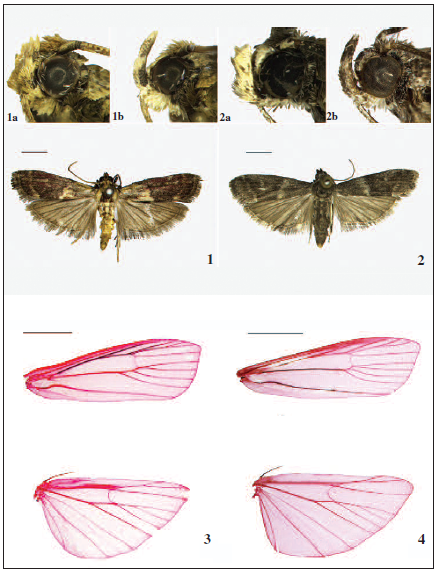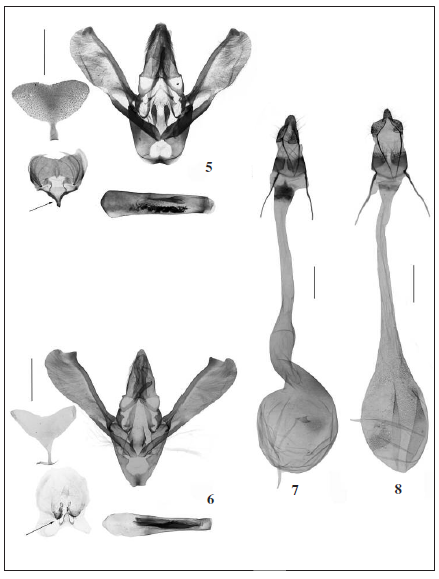

A new species of Glyptoteles Zeller, 1848 from China (Lepidoptera: Pyralidae, Phycitinae)
Una nueva especie de Glyptoteles Zeller, 1848 de China (Lepidoptera: Pyralidae, Phycitinae)
A new species of Glyptoteles Zeller, 1848 from China (Lepidoptera: Pyralidae, Phycitinae)
SHILAP Revista de lepidopterología, vol. 44, núm. 174, 2016
Sociedad Hispano-Luso-Americana de Lepidopterología
Recepción: 27 Diciembre 2014
Aprobación: 20 Enero 2015
Abstract: Glyptoteles proalatirubens Ren & Li, sp. n. is described, with photographs of adult and genitalia provided. Images of its allied species G. leucacrinella Zeller, 1848 are also given for comparison purposes.
Keywords: Lepidoptera, Pyralidae, Phycitinae, Glyptoteles, new species, China.
Resumen: Se describe Glyptoteles proalatirubens Ren & Li, sp. n., se proporcionan fotografías del adulto y genitalia. Se dan imágenes, para comparar, con la especie próxima G. leucacrinella Zeller, 1848.
Palabras clave: Lepidoptera, Pyralidae, Phycitinae, Glyptoteles, nueva especie, China.
Introduction
The genus Glyptoteles was established by ZELLER (1848) with G. leucacrinella Zeller, 1848 as the type species. REN & LI (2012) synonymized Rufalda absolutella Roesler, 1972, the type species of the genus Rufalda Roesler, 1972, with G. leucacrinella, and consequently proposed Rufalda as a junior synonym of Glyptoteles. Glyptoteles currently includes the type species only, distributed in China, Japan, Korea, Russia (Far East), central Europe (except British Isles) (HANNEMANN, 1964;ROESLER, 1972; IVINSKIS, 1984; SINEV, 1986; KIRPICHNIKOV & YAMANAKA, 1999; BAE, 2008; REN & LI, 2009, 2012; SLAMKA, 2010).
Glyptoteles is characterized by the sickle-shaped male labial palpus (Figs 1a, 2a) compressed laterally, bearing dense scales that form a serrate margin; the forewing with R3 + 4 and R5 stalked in basal half, M2 close to M3 at base, the hindwing with Rs and Sc stalked for basal 3/5 of Rs, M2 and M3 stalked in basal 2/5 (Figs 3, 4); the long triangular uncus, the slender and tapered gnathos, the narrowed transtilla fused terminally, the clubbed costa expanded distally, and the simple, paired culcita in the male genitalia (Figs 5, 6); and the ductus bursae longer than the corpus bursae, the subovate corpus bursae scobinate on the inner surface, and the ductus seminalis originating from near middle of the corpus bursae in the female genitalia (Figs 7, 8).
Glyptoteles resembles Kaurava Roesler & Küppers, 1981, but they can be separated by the following characters: in Glyptoteles, the sickle-shaped male labial palpus is laterally compressed, bearing dense scales forming a serrate margin; the uncus is triangularly elongate, the gnathos is shorter than the uncus, and the aedeagus has one cornutus in the male genitalia; the ductus bursae is longer than the corpus bursae, the ductus seminalis originates from the middle part of the corpus bursae in the female genitalia. Whereas in Kaurava, the male labial palpus is not laterally compressed, with normal scales not forming a serrate margin; the uncus is triangularly rounded, the gnathos is as long as the uncus, and the cornutus of the aedeagus is absent in the male genitalia; the ductus bursae is shorter than the corpus bursae, and the ductus seminalis originates from the posterior part of the corpus bursae in the female genitalia.
We describe Glyptoteles proalatirubens Ren & Li, sp. nov. in this paper. The type specimens are deposited in the Insect Collection, College of Life Sciences, Nankai University, Tianjin, China.
Glyptoteles proalatirubens Ren & Li, sp. n. (Figs 1, 3, 5, 7)
Type material: Holotype 1, CHINA, Jinxiu (24º 07’N 110º 11’E), Guangxi Zhuang Autonomous Region, 510 m, 14-IV-2002, coll. Shulian Hao and Huaijun Xue, gen. slide No. RYD04648. Paratypes: Guangxi Zhuang Autonomous Region: 5 11, 2 00, same data as for holotype; 3 11, 1 0, Qinmucun (24º 48’N 109º 59’E), Yongfu, 160 m, 1-4-V-2008, coll. Li Zhang & Hui Zhen; 1 1, Shaoping Yard (22º 05’N 106º 54’E), Pingxiang, 300 m, 20-VII-2011, coll. Bingbing Hu; 1 1, 1 0, Shaoping Yard, Pingxiang, 190 m, 24, 25-VII-2011, coll. Bingbing Hu; 1 1, Liusanjie (24º 31’N 108º 56’E), Yizhou, 169 m, 19-VIII-2011, coll. Shulian Hao & Yinghui Sun. Hainan Province: 2 11, Mt. Wuzhi (18º 48’N 109º 30’E), 700 m, 19-V-2007, coll. Zhiwei Zhang & Weichun Li; 1 1, 1 0, Mt. Diaoluo (18º 45’N 109º 51’E), 940 m, 31-V, 2-VI-2007, coll. Zhiwei Zhang & Weichun Li; 1 1, 1 0, Mt. Jianfeng (18º 42’N 108º 49’E), 940 m, 5-VI-2007, coll. Zhiwei Zhang & Weichun Li; 1 1, 1 0, Mt. Diaoluo, Lingshui, 300 m, 11-VIII-2008, coll. Bingbing Hu & Li Zhang; 2 11, 2 00, Mt. Yingge (19º 02’N 109º 32’E), 620 m£¬7, 9-V-2010, coll. Bingbing Hu & Jing Zhang; 4 00, 13-30-IX-2010, coll. Bingbing Hu. Yunnan Province: 1 0, Botanical Garden, Ruili (2400’N 9750’E), 1000 m, 6-VIII-2005, coll. Yingdang Ren; 4 00, Bubang (21º 36’N 101º 35’E), Mengla, 650 m, 22-25-VIII-2005, coll. Yingdang Ren; 1 1, Botanical Garden (21º 55’N 101º 16’E), Xishuangbanna, 531 m, 19-VIII-2010, coll. Yinghui Sun & Lixia Li. Genitalia slide Nos. RYD04646m, LJY10182m, LJY10183m, LJY10401m, LJY10402m, LHX14074m, RYD04649f, RYD04683f, LHX14075f, LHX14076f.
Description: Adult (Figs 1, 3). Wingspan 14.0-17.5 mm. Head yellowish brown. Antenna yellowish brown on dorsal surface, cilia short on ventral surface; sinus of male flagellum gentle, with short, yellowish brown scale tufts. Labial palpus upturned, in male (Fig. 1a) compressed laterally, sickle-shaped, bearing dense scales forming a serrate margin, three segments about same length, yellowish brown except black at middle of each segment; in female (Fig. 1b) bent over vertex, yellowish brown, second and third segments about same length, slightly longer than first segment. Patagium, tegula and thorax yellowish brown. Forewing grayish brown, scales blacktipped, with numerous reddish brown scales along veins; antemedian line blackish brown, sinuate, oblique outwardly, with a large, subtriangular, creamy yellow patch on inner side of its lower half; discal spot absent; postmedian line yellowish white, sinuate, concave at M1 and A; terminal line black; cilia grayish brown. Hindwing grayish brown, with a line of long, bristle-like scales at base of costa; cilia light gray. Legs yellowish brown, mixed with numerous black scales. Abdominal segments yellowish brown.
Male genitalia (Fig. 5): Uncus elongate, subtriangular, bluntly rounded at apex, densely setose on dorsal surface. Apical process of gnathos clubbed, about 3/5 length of uncus. Transtilla fastigiate. Valva slightly broadened from base to rounded apex, concave at middle on ventral margin, bearing fine setae in distal 2/3; costa extending to end of valva, triangularly expanded apically; sacculus clubbed, slightly narrowed from base to end, 8/11 length of costa. Vinculum Ushaped, concave at middle of anterior margin. Juxta U-shaped; lateral lobe fingerlike, about 2/3 length of apical process of gnathos, with sparse setae distally. Aedeagus cylindrical, slightly tapering from base to apex; cornutus represented by a long reversely tapered thorn; a band composed of spinules from basal 1/4 to 3/4 parallel with cornutus. Eighth sternite a narrow Vshaped band, tergite somewhat fan-shaped, protruded antero-medially. Culcita paired.
Female genitalia (Fig. 7): Anal papillae triangular, bearing dense long setae. Antrum nearly quadrate, protruded triangularly at middle on posterior margin. Ductus bursae elongate, about 2.0 times length of corpus bursae, narrowed in posterior 2/3, broadened in anterior 1/3, scobinate at junction with corpus bursae. Corpus bursae round, scobinate in posterior half, with concentration at transition to corpus bursae, forming an obvious ovate area; signum absent. Ductus seminalis incepted at middle of corpus bursae.
Diagnosis: This new species is similar to G. leucacrinella. It can be distinguished from the latter by the forewing with numerous reddish brown scales along veins and having a subtriangular, creamy yellow patch on the inner side of the antemedian line; the fastigiate transtilla, the apical process of gnathos about 3/5 length of the uncus, the costa reaching the end of the valva, the juxta with the lateral lobe about 2/3 length of gnathos, and the eighth sternite V shaped in the male genitalia; and the nearly square antrum in the female genitalia. In G. leucacrinella, the forewing lacks reddish brown scales along veins and it has a narrow, indistinct grayish white band on the inner side of the antemedian line (Fig. 2); the transtilla is arched, the apical process of the gnathos is about 1/2 length of the uncus, the costa does not reach the end of the valva, the lateral lobe of the juxta is about 1/3 length of the gnathos, and the eighth sternite is A shaped in the male genitalia (Fig. 6); and the antrum is band-shaped in the female genitalia (Fig. 8).
Distribution: China (Guangxi, Hainan, Yunnan).
Etymology: The specific name is derived from the Latin proalatus (forewing), and Rubens (red) referring to the forewing bearing numerous reddish brown scales along veins.


Agradecimientos
We express our thanks to Dr. Antonio Vives (Spain) for translating the abstract to Spanish, and to the anonymous reviewers for their comments to improve the manuscript. This research was supported by the National Natural Science Foundation of China (No. 31172141 and No. 31093430) and partly funded by the Basic Scientific Research Project of Henan Academy of Agricultural Sciences (No. 2013JC22).
BIBLIOGRAPHY
BAE, Y. S., BYUN, B. K. & PAEK, M. K., 2008.– Pyralid Moths of Korea (Lepidoptera, Pyraloidea): 426 pp.. Korea National Arboretum. Samsungad Com., Seoul.
HANNEMANN, H. J., 1964.– Kleinschmetterlinge oder Microlepidoptera II. Die Wickler (s. l.) (Cochylidae und Carposinidae). Die Zünslerartigen (Pyraloidea).– Die Tierwelt Deutschlands, 50: I-VIII, 1-401, pls. 1-22.
IVINSKIS, P. P., 1984.– A Key to the Phycitidae family of pyralids (Lepidoptera, Pyraloidea) from USSR European part according to the female genitalia.– Acta Entomologica Lithuanica, .: 46-71, 82 figs. (in Russian).
KIRPICHNIKOV, V. A. & YAMANAKA, H., 1999.– Pyraloidea: Phycitinae.– In A. S. LELEJ (ed.). Key to the insects of the Russian Far East, .. Trichoptera and Lepidoptera, (2): 672 pp. Dalnauka, Wladivostock.
LI, H. H & REN, Y. D., 2009.– Pyralidae: Phycitinae. 59-144.– In H. H. LI & Y. REN et al.. Insect Fauna of Henan (Lepidoptera: Pyraloidea): 440 pp, 46 pls. Science Press, Beijing.
LI, H. H & REN, Y. D., 2012.– Pyraloidae: Phycitinae. 288-417.– In H. H. LI & Y. REN et al.. Microlepidoptera of Qinling Mountains (Insecta: Lepidoptera):1271 pp, 35 pls. Science Press, Beijing.
ROESLER, R. U., 1972.– Phycitidae. X. Lepidoptera, Pyralidae.– Entomologische Zeitschrift, 82(23): 257-267.
ROESLER, R. U. & KÜPPERS, P. V., 1981.– Die Phycitinae (Lepidoptera: Pyralidae) von Sumatra; Taxonomie Teil B, Ökologie und Geobiologie.– Beiträge zur Naturkundlichen Forschung in Südwestdeutschland, Karlsruhe Beih., .: 1-282.
SINEV, S., 1986.– Phycitidae.– In G. S. MEDVEDEV. Key to the insects of the European part of the USSR, .: 504 pp. Akademia Nauk, Leningrad. (in Russian).
SLAMKA, F., 2010.– Pyraloidea (Lepidoptera) of Central Europe. Identification-Distribution -Habitat-Biology: 176 pp., 12 pls. Frantisˇek Slamka, Bratislava.
ZELLER, P. C. 1848.– Die Gallerien und nackthornigen Phycideen.– Isis von Oken, 1848 (8-10): (8) 569-618, (9) 641-691, (10) 721-754.
Notas de autor